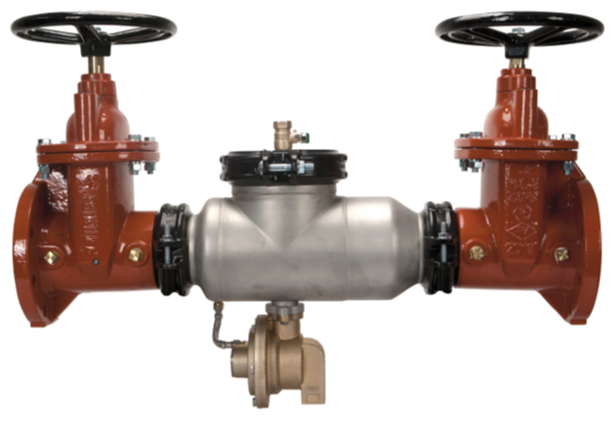 Image: Zurn Wilkins 375AST Reduced Pressure Principle Backflow Preventer
Image: Zurn Wilkins 375AST Reduced Pressure Principle Backflow Preventer
Myth Busting: What You May Not Know About Backflow Prevention
What is Backflow?
When Does Backflow Occur?
Backflow is caused by pressure changes, including conditions of gravity, vacuum, or other pressure changes. There are two factors that contribute to reversal of flow in pipelines. One is backsiphonage and the other is backpressure.
Before you install your next system. Here are a few common misconceptions around backflow prevention, and what you should know before you select your model.
Myth: Assemblies vs. Devices: These are the same
Mechanical backflow prevention devices and assemblies offer the best protection against cross-connection hazards, but they are not the same. Backflow prevention assemblies consist of an inlet and outlet shut-off valve and test cocks to facilitate testing of the assembly while it is in its functional in-line position. Backflow prevention devices prevent backflow by stopping the reversal of flow and are not testable once installed because they do not have inlet and outlet shut-off valves or test cocks.
Myth: Backflow Assemblies cover all hazard applications
You must understand the degree of hazard in your system to determine the proper solution and backflow assembly device you choose.
Low-hazard application: potential backflow can pollute the drinking water. Pollution refers to undesirable effects to the water that will not cause illness, such as discoloration, smell, or taste. The Zurn Wilkins Double Check Backflow Preventers provide low hazard protection from backsiphonage and backpressure for all water application.
High-hazard application: potential backflow can contaminate the water supply. Contamination refers to any impairment to the quality of water that can result in illness. The Zurn Wilkins Reduced Pressure Principle Backflow Preventers provide high hazard protection against backsiphonage and backpressure for all water applications
Myth: Zurn Wilkins Backflow Assemblies model numbers don’t help me identify the assembly type
By just looking at the last two digits of our backflow preventer model numbers you will be able to understand if this assembly is a Double Check Assembly (DC) or a Reduced Pressure Principle Assembly (RP).
Zurn Wilkins Double Check Assemblies (DC) and Zurn Wilkins Double Check Detector Assemblies (DCDA) always use the number 50 in the model number. DC Models include: 950XLT2, 950XL, 350XL, 350, 350A, 350AST, 450, 450ST. DCDA Models include: 950XLTDA, 350DA, 350ADA, 350ASTDA, 450DA, 450STDA
Zurn Wilkins Reduced Pressure Principle Assemblies (RP) and Zurn Wilkins Reduced Pressure Principle Detector Assemblies (RPDA) always use the number 75 in the model number. RP Models include: 975XL2, 975XL, 375XL, 375, 375A, 375AST, 475, 475ST. RPDA Models include: 375DA, 375ADA, 375ASTDA, 475DA, 475STDA
Myth: Innovation does not happen in Backflow Prevention due to the required standards, approvals and listings needed.
Approval agencies, representing many diverse geographical areas and levels of government, require performance criteria regarding the function, manufacturing, installation, and testing and maintenance of backflow prevention devices and assemblies. These standards ensure the integrity of the drinking water by addressing each mechanical function, and materials of the backflow preventers *Design*. Although this testing is quite rigorous and intense our engineering team continues to be inventive in designing backflow assemblies. Any new backflow preventer assembly that comes to market with the required approvals and listings has been thoroughly vetted and in development with Zurn Wilkins engineers for multiple years before it has come to the market.
Speaking of innovative, check our video on the Zurn Wilkins 300 Small Backflow Series to hear more about how our engineers and product management are designing products to set us above the competition.
To learn more about Backflow Prevention and Zurn Wilkins Backflow Preventers check out the following brochure: Principles of Backflow Prevention





